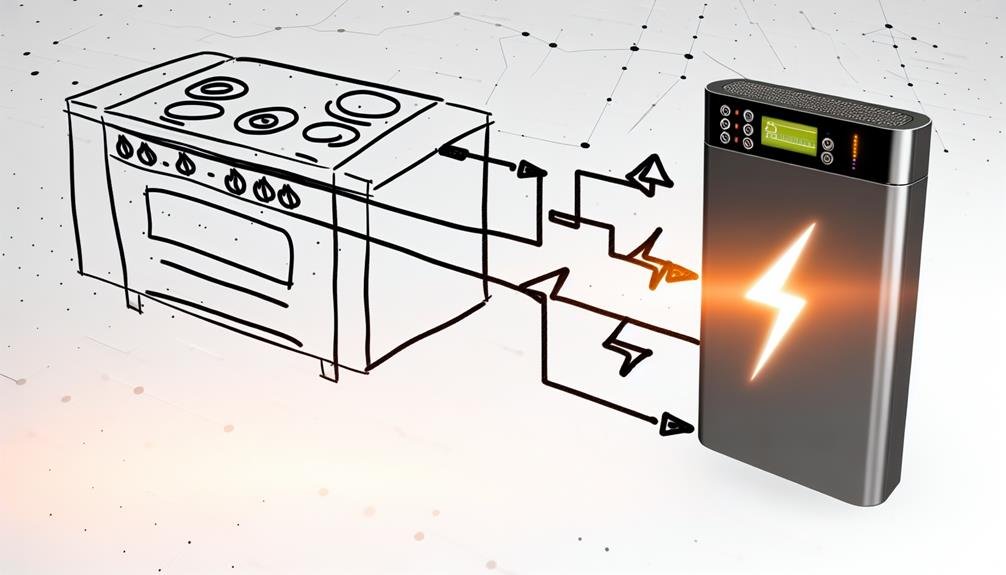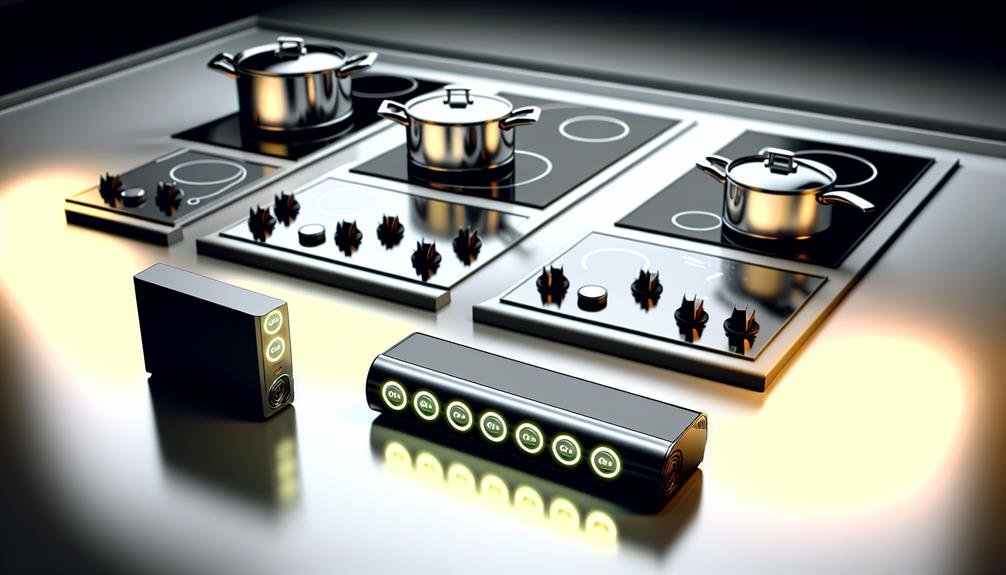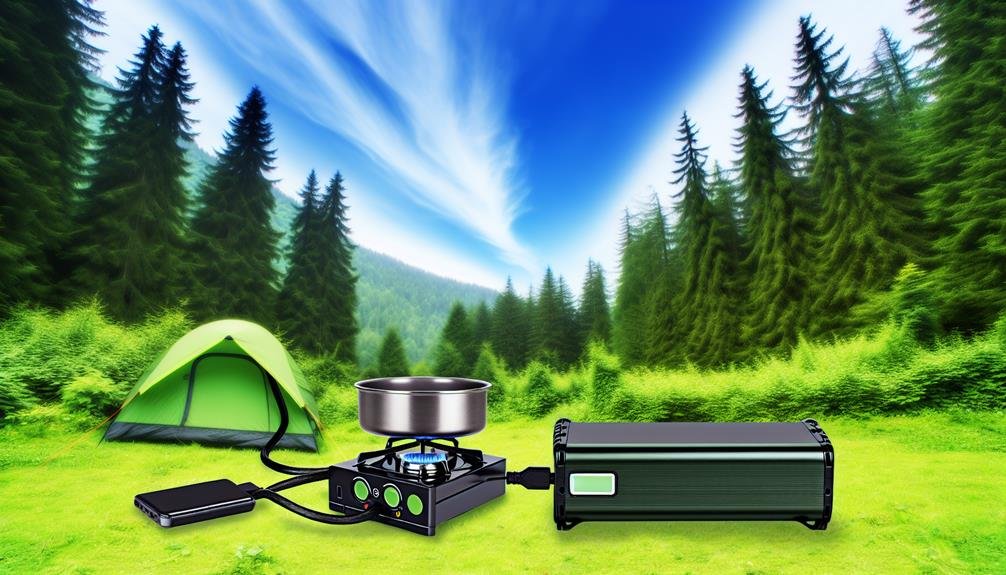A standard power bank usually can't power a stove. Most stoves, especially electric and induction types, demand between 1,200 to 3,000 watts. Power banks are designed for low-power devices like phones, offering much lower output. Even outdoor stoves with integrated battery systems need substantial energy that typical power banks don't provide. You'd need to assess your stove's specific wattage requirements and match them with the power bank's capacity. For practical alternatives, portable generators or solar panels might be suitable. Understanding your power needs and available options can help you decide effectively. Learn more about compatibility and solutions.
Understanding Power Bank Capacity

When determining whether a power bank can power a stove, you need to understand its capacity, typically measured in milliampere-hours (mAh) or watt-hours (Wh). Battery capacity indicates how much energy a power bank can store. For instance, a power bank rated at 20,000 mAh or 74 Wh holds a substantial amount of energy, but that alone doesn't tell the entire story.
You must also consider the power output, generally measured in volts (V) and amperes (A). Power output determines how much energy the power bank can deliver at a given moment. High-capacity power banks often feature multiple output ports with varying power levels. For a stove, which requires significant and continuous power, the power bank must consistently deliver high wattage.
Safety is paramount. Verify that the power bank's output specifications match or exceed those required by the stove to prevent overheating or damage. Using a power bank with inadequate power output could result in malfunction or potential safety hazards. Additionally, check for built-in safety features like overcharge protection and short-circuit prevention to ensure both your device and your power bank remain secure during use.
Energy Requirements of Stoves
Stoves typically demand a high and continuous power supply, often measured in watts, to function effectively. Understanding the energy requirements of stoves is essential for ensuring safe and efficient operation. Here are three key points to keep in mind:
- Power Consumption: Stoves generally consume between 1,200 to 3,000 watts, depending on their size and type. This high power usage translates to significant energy consumption, which needs to be continuously supplied to maintain stove efficiency.
- Energy Sources: Traditional stoves rely on electricity or gas as their primary energy sources. Electric stoves require a stable electrical grid, while gas stoves depend on a consistent supply of propane or natural gas. Both sources provide the necessary continuous energy to keep the stove functioning safely.
- Safety Mechanisms: Modern stoves include built-in safety features such as automatic shut-off mechanisms and temperature controls. These features are designed to prevent overheating and potential hazards, ensuring the safety of the user.
When contemplating whether a power bank can power a stove, you need to assess whether the power bank can consistently meet these high energy demands. The energy requirements of stoves make it clear that only specific, high-capacity energy sources can safely and efficiently power them.
Types of Stoves and Compatibility

Different varieties of stoves, like induction, gas, and electric, each have unique power needs and compatibility considerations. Induction stoves use electromagnetic fields and require a substantial power supply, often surpassing what standard power banks can provide. Gas stoves, conversely, depend on combustible fuel such as propane or butane, making them independent of electrical power but needing proper ventilation for safety. Electric stoves, including those tailored for portable choices, are more adaptable but still require significant wattage to function efficiently.
With advancements in cooking appliance technology, there are now stoves specifically made for outdoor cooking that integrate battery-powered ignition systems and low-wattage heating components. These models are more likely to be compatible with high-capacity power banks, but it's important to match the power bank's output capabilities with the stove's power needs to guarantee safe and efficient use.
When considering compatibility, always confirm the power rating of both the stove and the power bank. Overloading a power bank can result in overheating or malfunction, presenting significant safety hazards. Thorough examination of the wattage and amperage is necessary to ensure a safe and pleasant cooking experience, especially in outdoor environments.
Practical Real-World Tests
To establish the real-world feasibility of using a power bank to power a stove, we must conduct practical tests that evaluate both performance and safety. You'll need to understand the power bank limitations and the stove performance metrics to guarantee a valid and safe experiment. For an accurate assessment, follow this structured approach:
- Power Output Testing: Measure the power bank's output capacity. Most stoves require high wattage, often exceeding typical power bank capabilities. Assess if the power bank can consistently deliver the required wattage without overheating or draining too quickly.
- Stove Compatibility: Test various types of portable stoves, noting their power requirements and operational efficiency. Document each stove's performance when connected to the power bank, paying close attention to ignition, heating time, and temperature control.
- Safety Protocols: Implement stringent safety checks. Ensure all connections are secure, monitor for any signs of electrical issues like short circuits, and have fire suppression resources on hand.
Alternative Solutions and Recommendations

Considering the limitations of power banks for powering stoves, exploring alternative solutions like integrated battery systems and portable solar panels can provide more reliable and efficient options. Integrated battery systems are engineered to handle higher power loads, making them suitable for powering high-wattage appliances like stoves. These systems often come with built-in safety features, ensuring stable power delivery and protecting against surges.
Portable solar panels are another excellent alternative. They convert sunlight into electrical energy, which can then be stored in larger battery systems for later use. This eco-friendly option is particularly beneficial for outdoor and off-grid scenarios where conventional power sources are unavailable. When selecting a solar panel, consider its wattage, efficiency, and compatibility with your battery system to ensure best performance.
For immediate power needs, portable generators serve as a robust solution. They can deliver high wattage and operate various appliances concurrently. However, it's vital to choose a generator that meets safety standards and includes features like overload protection and automatic shut-off.
Here's a quick comparison:
| Solution | Advantages | Considerations |
|---|---|---|
| Integrated Battery | High power capacity | Initial cost |
| Solar Panels | Eco-friendly, renewable | Weather-dependent |
| Portable Generators | High wattage output | Fuel and maintenance |
Frequently Asked Questions
How Long Does It Take to Fully Charge a Power Bank?
Charging time depends on your power bank's capacity and charging speed. Higher capacity units take longer. Charging efficiency varies, but generally, it takes 3-6 hours. Always use the recommended charger to guarantee safety and best performance.
Are There Safety Risks Using Power Banks With Stoves?
Imagine taming a dragon with a butterfly net. It's important to take into account power bank compatibility with stoves, as mismatched devices might create dangerous fire hazards. Always prioritize safety by consulting manufacturer guidelines and ensuring proper usage.
What Is the Average Lifespan of a Power Bank?
The average lifespan of a power bank depends on battery longevity, charging habits, impact of temperature, and usage patterns. Proper management of these factors can extend a power bank's life, typically ranging from 300 to 500 charge cycles.
Can Solar Panels Charge Power Banks Efficiently?
Yes, solar panels can charge power banks efficiently, but it depends on the solar panel efficiency and the power bank capacity. Make sure your solar panels provide sufficient wattage to match your power bank's requirements for safe and best charging.
Are There Environmentally Friendly Power Bank Options?
Imagine a serene forest. Yes, there are environmentally friendly power bank options. They're crafted from eco-friendly materials and utilize sustainable charging options, ensuring both your device and the planet are safe and sound.



